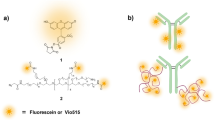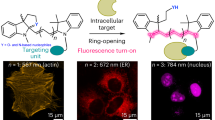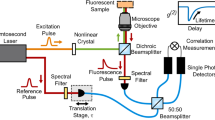Abstract
THE technique by which measurements of the depolarization of fluorescence of protein conjugates is used for investigating rotational relaxation has been applied mainly with the fluorescent dye, 1-dimethylamino-naphthalene-5-sulphonic acid (I) 1,2. The life-time of the excited state (τ) of this dye when conjugated to protein has been measured by independent methods by Weber3 and by Steiner and McAlister4. Good agreement was reported, and in the present work the value τ = 1.18 × 10−8 sec. (probably accurate to ± 0.05 × 10−8), the mean of several determinations on conjugates with bovine serum albumin by Steiner and McAlister, has been assumed throughout. Assuming an absolute error in the experimental estimates of degree of polarization (p) of ± 0.003, it can be shown that the dye (with P 0 = 0.25, the subscript referring to zero value of the temperature/viscosity ratio) is adequate for measuring relaxation times in the range 0.5–30 × 10−8 sec. to an accuracy of ± 10 per cent. These relaxation times correspond to a molecular weight range of 5,000–300,000 if the molecule is spherical and unhydrated. The corresponding molecular weights for hydrated and moderately asymmetric molecules will be less, usually by a factor of at least 2 or 3. The range is determined mainly by the magnitude of τ and the accuracy of measurements of the degree of polarization of the fluorescent light. If dyes having longer and shorter values of τ were available, the range of the method would be considerably extended.
This is a preview of subscription content, access via your institution
Access options
Subscribe to this journal
Receive 51 print issues and online access
$199.00 per year
only $3.90 per issue
Buy this article
- Purchase on SpringerLink
- Instant access to full article PDF
Prices may be subject to local taxes which are calculated during checkout
Similar content being viewed by others
References
Weber, G., Biochem. J., 51, 145 (1952).
Weber, G., Biochem. J., 51, 155 (1952).
Weber, G., “Adv. Prot. Chem.”, 8, 415 (1953).
Steiner, R. F., and McAlister, A. J., J. Poly. Sci., 24, 105 (1957).
Euhleke, H., Z. Naturforschung, 131, 722 (1958).
Chadwick, C. S., McEntegart, M. G., and Nairn, R. C., Immunol., 1, 315 (1958).
Oncley, J. L., Chem. Rev., 30, 433 (1942).
Chadwick, C. S., and Johnson, P. (to be published).
Author information
Authors and Affiliations
Rights and permissions
About this article
Cite this article
CHADWICK, C., JOHNSON, P. & RICHARDS, E. Depolarization of the Fluorescence of Proteins labelled with Various Fluorescent Dyes. Nature 186, 239–240 (1960). https://doi.org/10.1038/186239a0
Issue date:
DOI: https://doi.org/10.1038/186239a0
This article is cited by
-
Fluorescence of eosinophil leucocyte granules induced by 1-hydroxy-3,6,8-pyrenetrisulfonate. Visualization of differences in protein isoelectric points
Histochemistry And Cell Biology (1995)



